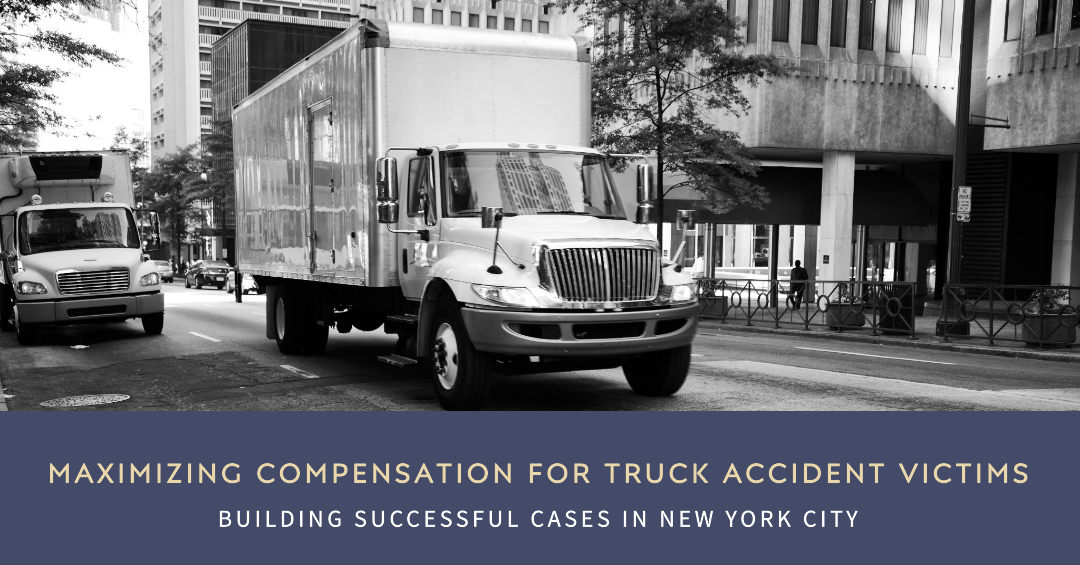Building Successful Truck Accident Cases: Maximizing Compensation for New York City Truck Accident Victims
To outsiders, truck accident settlements may seem eye-popping. In recent years, an Idaho jury awarded $27 million in damages to the family of a woman killed in a trucking accident. Similar multi-million dollar verdicts have been awarded in states like Texas, Louisiana, Connecticut, California, Illinois, and Indiana.[1] These seemingly lucrative verdicts starkly contrast with the harsh realities faced by those whose lives are tragically upended or ended by trucking accidents.
Understanding NYC Truck Accident Settlements
Why Are Truck Accident Settlements So Large?
Not every truck accident case is settled for millions of dollars. Many cases settle for far less, and some are outright unsuccessful. The public’s perception of these settlements can often be skewed by reporting bias.
However, there are reasons why some truck accident settlements and jury verdicts can reach substantial amounts. As discussed below, New York law allows juries to award damages for various types of injuries—both economic and non-economic. Truck accidents often result in catastrophic injuries or fatalities, leading to lifelong disabilities, enormous medical bills, funeral expenses, lost income, and, in the worst cases, the loss of human life. All of these are compensable under the law and can lead to significant settlements.
Beyond the compensability of injuries, large jury verdicts can drive settlements upward. Defendants in truck accidents often prefer to settle because settlements are generally less costly than risking a large jury verdict at trial.
The Pivotal Role of Insurance in Truck Accident Cases
Truck accident cases are a type of personal injury case, and insurance policies play a significant role in every personal injury case. As previously discussed, settlements and verdicts can reach sizable amounts in truck accident cases. Even business defendants often lack the funds to pay the entire settlement or verdict.
Insurance funds are necessary to compensate injured people for their losses after a successful truck accident case. The United States government recognizes this necessity, requiring every trucking company (sometimes referred to as “carriers”) to establish financial responsibility for a minimum of $750,000 in insurance policies to ensure people injured in trucking accidents can be compensated for their medical costs.[2] However, $750,000 is often inadequate to cover the entire settlement or verdict, so damages awarded beyond that amount are often paid by the companies themselves if they maintain only the minimum coverage.
But there is another reason for requiring carriers to maintain insurance coverage: it provides a financial incentive for them to engage in safe practices.[3] Before issuing a policy, an insurance company will investigate the policies and procedures of the trucking company to ensure that the insurer has adequately evaluated the risk it is agreeing to insure.[4] If, after investigation, the insurance company determines that the carrier is engaged in unsafe practices, it will either charge significantly higher premiums or refuse to issue a policy at all. Evaluating safety risks is one of the primary endeavors of an insurance company, and the government recognizes that insurance companies are best positioned to monitor the safety compliance of these trucking companies by requiring insurance policies.
Building a Strong NYC Truck Accident Case
Thorough investigations, proficient use of expert witnesses, and a deep understanding of the Federal Motor Carrier Safety Regulations (FMCSRs) are the foundations of a strong NYC truck accident case. Each of these will be explored in turn.
A Proper Investigation is a Prompt Investigation
NYC personal injury lawyers litigating truck accident cases must immediately begin gathering evidence.[5] Specifically, the NYC personal injury attorney working on a truck accident case will want to ensure the preservation of and then inspect all of the vehicles involved in the accident. That inspection may reveal the vehicles’ general maintenance leading up to the accident and determine the precise locations of impact. It may also lead to the discovery of the truck driver’s logbook, the vehicle’s maintenance records, prescription drug or alcohol containers indicating a driver’s illness or substance abuse, and a variety of other relevant evidence.[6]
Efficient Use of Expert Witnesses
Another facet of a successful truck accident case is the attorney’s choice of expert witnesses. The attorney will almost always want to use an expert witness on the trucking industry as a whole.[7] That expert witness can provide testimony regarding the proper maintenance of the truck, appropriate safety practices for companies and drivers, how to properly secure loads, the correct brake systems for large commercial vehicles, and many other areas.[8] The selection of this expert should be made based on the facts of a given case, ensuring that the expert chosen is best suited to analyze and testify about the specific facts of that case.
Given that sleep deprivation is such a common cause of truck accidents, many cases will necessitate the use of a sleep expert.[9] This expert can help to quantify the impact of sleep deprivation on truck drivers. That quantification—in conjunction with testimony from a trucking industry expert about the regulations intended to prevent truckers from falling asleep at the wheel—gives context to how the driver’s sleep deprivation was caused by inadequate adherence to trucking safety regulations regarding hours-of-service.[10]
The FMCSRs Are the Rules of the Road in Truck Accident Litigation
The Federal Motor Carrier Safety Administration (FMCSA) is an agency established by Congress to reduce trucking crashes, injuries, and fatalities.[11] The FMCSA endeavors to reduce crashes, injuries, and fatalities by issuing the Federal Motor Carrier Safety Regulations, which are federal regulations (adopted by New York) that govern the trucking industry.
The FMCSRs govern every aspect of trucking. Drivers who violate them, as well as their employers, can both be held liable for injuries caused by those violations.[12] New York tort law is clear that violations of the FMCSRs are very strong evidence of negligence—though they do not constitute negligence per se—if the violation of the FMCSR is proven to have caused the other party’s injury in the truck accident.[13]
Maximizing Compensation in NYC Truck Accidents
To maximize the compensation received in a settlement for a NYC truck accident, it is critical to understand two things. First, one must understand why the law allows them to recover damages—economic or non-economic damages—for the catastrophic injuries suffered in the accident. Second, one must understand who may collect those damages, particularly in fatal truck accident cases, and how that fatality impacts the damages that may be awarded.
Damages: An Overview of the Legal Remedies Available in NYC Truck Accidents
It is critical to understand the different types of damages available to people injured in trucking accidents in New York. People are entitled to recover damages that necessarily, usually, and immediately flow from a personal injury caused by another person’s negligence.[14] These damages are an implied result of the person’s conduct under the law, meaning that the injured person need only make a general allegation in the complaint that the damages were caused by their injury.[15] Damage awards for pain and suffering occurring as a natural and necessary result of an injury are the most common example of damages that are implied results of the defendant’s conduct, which can be alleged in a general sense.
However, New York law requires other damages to be alleged specifically in the complaint. In the context of a truck accident case, these damages commonly include medical expenses. Trucking accident plaintiffs who have suffered catastrophic injuries are entitled to recover bills for medical, hospital, and nursing expenses incurred if they meet two requirements. First, the plaintiff must plead and prove the amount of those expenses in sufficiently definite terms that a jury can determine the value of the medical, hospital, and nursing services rendered to the plaintiff.[18] Second, the plaintiff must also show that the medical expenses incurred in the truck accident were proper, reasonable, and necessary in light of the circumstances.[19]
A second category of damages that a plaintiff injured in an NYC truck accident may seek are those for permanent injuries. Specifically, a plaintiff seeking compensation for permanent injuries must plead that the injury is permanent.[20] At trial, the plaintiff will likely have to present a physician’s testimony to prove that the catastrophic injuries suffered in the trucking accident are permanent.[21] In a similar vein, anyone alleging that the trucking accident aggravated a preexisting condition must also plead the aggravation and provide sufficient evidence of that aggravation.[22]
Finally, plaintiffs injured in NYC truck accidents are entitled to economic damages for lost earnings or impairment of their earning capacity.[23] Lost earnings and impaired earning capacity must both be specifically pleaded and proven.[24]
Wrongful Death Claims
New York statute allows the personal representative of a deceased person to bring a lawsuit to recover damages for the wrongful act, neglect, or default that caused the deceased person’s death against anyone who would have been liable to the deceased person for that wrongful conduct.[25] Wrongful death actions serve to protect the rights of victims and families impacted by fatal truck accidents by allowing the deceased person’s surviving spouse and next of kin to bring the lawsuit their deceased family member could have brought if they were still alive.[26] The specific right protected by wrongful death actions is the right to compensation that the deceased person would have had if they had survived.
Wrongful death claimants can recover all of the damages discussed above plus general damages for the pecuniary loss they suffered due to the death.[27] The compensable pecuniary losses generally include the decedent’s loss of earnings, the value of the loss of services each of the survivors might have received from the decedent, loss of parental guidance from the decedent for the deceased person’s children, and the possibility of inheritance from the decedent.[28] Wrongful death lawsuits can also recover medical and funeral expenses incidental to the death.
Choosing the Right NYC Truck Accident Attorney
People injured in trucking accidents and the families of those killed in such accidents are rarely well-positioned to judge the quality of a particular truck accident attorney in New York. This lack of knowledge places these families between a metaphorical rock and a hard place. They may feel forced to choose between (1) hiring an attorney they know little about to represent them in a legal proceeding they do not fully understand, or (2) losing precious time to gather evidence in the wake of the accident so they can make the best choice of lawyer.
How to Choose the Right Lawyer
The choice of lawyer is a crucial decision that should not be taken lightly, but there are certain things families can look for when selecting an attorney. First, clients can search for their prospective attorney’s discipline records online, and they can find that database linked here.
There are other criteria to consider once a client knows the person they are hiring to handle this critical matter is in good standing. People seeking compensation for injuries caused in a truck accident will assuredly want an attorney who has experience litigating these cases. Personalized client service is another important issue. When interviewing attorneys, ask how many cases they currently have, how many of those cases are truck accidents, and how many cases they typically litigate at one time.
Representation on Contingency Fees
Legal services are expensive, and many people cannot afford to hire an attorney on an hourly basis. However, truck accident cases seeking financial compensation for personal injuries suffered in the accident are commonly handled on a contingency fee basis.
Essentially, a contingency fee is a method of paying the truck accident attorney where the attorney agrees not to charge the client until the case is resolved and payments are certain. Many people think of contingency fees as an agreement that, if successful in settling or winning the case at trial, the attorney will be entitled to a percentage of the settlement or damages awarded at trial. These percentages generally run between 25-40%.
Contingency fees are essential for ordinary people to afford attorneys in the American legal system. As previously stated, most people simply do not have the money to pay their lawyers on an hourly basis. But make no mistake: trucking companies and their insurers absolutely do. The contingency fee ensures effective representation of the injured people against those companies despite the significant gap in their resources.
Conclusion
Successful trucking settlements are premised on understanding the law of damages, the best way to protect a client’s right to receive compensation, and how to conduct an effective investigation of the accident. After that investigation is complete, efficient use of expert witnesses and a deep knowledge of the FMCSRs will help NYC truck accident attorneys representing injured people maximize the value of their settlements and jury verdicts.
If you or a family member have been injured in a commercial trucking accident, contact the attorneys at [LAW FIRM]. Our attorneys have years of experience litigating trucking accidents. Those years of experience have taught them the value of a thorough investigation, the ins and outs of the FMCSRs, and the importance of prompt client service. Our attorneys operate on a contingency fee basis, meaning the client only pays us a percentage of what we are able to recover for them.
Whether you’re dealing with injuries from a car accident, construction accidents, or a wrongful death case, our attorneys are here to provide compassionate support.
[1] CRC Group, Severity & Frequency of Truck Accidents is on the Rise (accessed August 8, 2024),
[2] 49 C.F.R. §§ 387.8(a), 387.9.
[3] Litigating Truck Accident Cases § 3:3 (Apr. 2024).
[4] Id.
[5] Litigating Truck Accident Cases § 2:2 (Apr. 2024).
[6] Id.
[7] Litigating Truck Accident Cases § 7:70 (Apr. 2024).
[8] Id.
[9] Litigating Truck Accident Cases § 6:4 (Apr. 2024).
[10] Id.
[11] 49 U.S.C.A. § 113 (2024).
[12] Luizzi v. Pro Transport, Inc., No. 02 CV 5388(CLP), 2013 WL 3968736, at *26 (E.D.N.Y. July 31, 2013).
[13] Elliott v. City of New York, 95 N.Y.2d 730, 735-36 (N.Y. App. Ct. 2001).
[14] Keefe v. Lee, et al., 197 N.Y. 68 (N.Y. App. Ct. 1909).
[15] Rosenberg v. Schwartz, 260 N.Y. 162, 183 N.E. 282 (N.Y. 1932). A case underscoring the importance of specificity in damage claims for medical expenses in personal injury cases.
[16] Furey v. U.S., 458 F. Supp. 3d 136 (S.D.N.Y. 2020). Emphasizes that pain and suffering damages should be considered as a natural and necessary result of the injury in personal injury claims.
[17] Stengel v. Thompson, 56 A.D.2d 731, 392 N.Y.S.2d 248 (N.Y. App. Div. 1977). Notes the requirement for medical expenses to be specifically stated in the complaint for recovery.
[18] Gill v. Brahms, 33 A.D.2d 722, 306 N.Y.S.2d 581 (N.Y. App. Div. 1969). Establishes that medical, hospital, and nursing expenses must be definitively proven to allow for jury determination.
[19] Perkins v. Coughlin, 35 A.D.2d 994, 317 N.Y.S.2d 209 (N.Y. App. Div. 1971). Holds that medical expenses claimed must be necessary and appropriate given the circumstances of the injury.
[20] Nolan v. State of New York, 283 N.Y. 384, 28 N.E.2d 826 (1940). Clarifies that permanent injuries must be explicitly alleged in the complaint.
[21] Reilly v. Freeman, 23 A.D.3d 1116, 805 N.Y.S.2d 210 (N.Y. App. Div. 2005). Requires that claims of permanent injuries should generally be supported by a physician’s testimony.
[22] Foltz v. City of New York, 28 Misc. 2d 478, 215 N.Y.S.2d 859 (Sup. Ct. 1961). Specifies the need for sufficient evidence when claiming aggravation of preexisting conditions in personal injury suits.
[23] Johnson v. Manhattan & Bronx Surface Transit Operating Authority, 71 N.Y.2d 198, 519 N.E.2d 326 (N.Y. 1988). Discusses the recovery of economic damages, including lost earnings in personal injury cases.
[24] Young v. Tops Markets, Inc., 283 A.D.2d 923, 724 N.Y.S.2d 660 (N.Y. App. Div. 2001). Establishes the requirement to specifically plead lost earnings and impaired earning capacity.
[25] N.Y. Est. Powers & Trusts Law § 5-4.1. The statute grants personal representatives the authority to bring wrongful death actions on behalf of the deceased’s estate.
[26] Gonzalez v. New York City Housing Authority, 77 N.Y.2d 663, 572 N.E.2d 598 (N.Y. 1991). Discusses the rights of surviving family members to pursue wrongful death claims.
[27] Tilly v. Hudson River Railroad Co., 29 N.Y. 252 (N.Y. 1864). Recognizes pecuniary loss as a recoverable element in wrongful death actions.
[28] Parilis v. Feinstein, 49 N.Y.2d 984, 429 N.Y.S.2d 165 (N.Y. 1980). Defines the specific pecuniary losses compensable under New York’s wrongful death statutes, including lost income, services, parental guidance, and potential inheritance.






